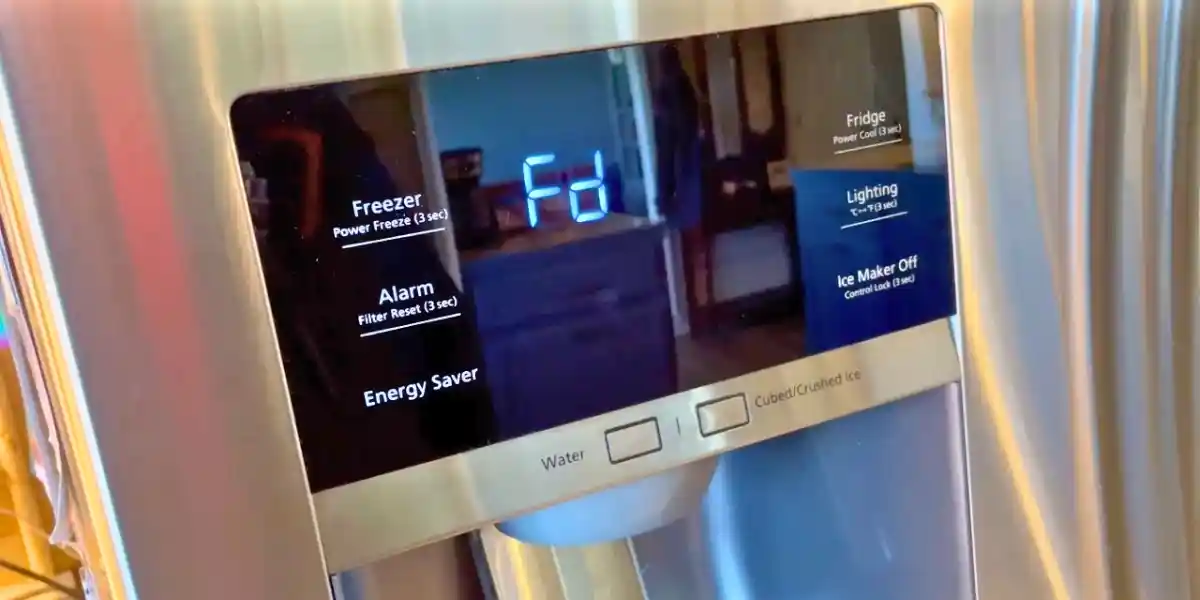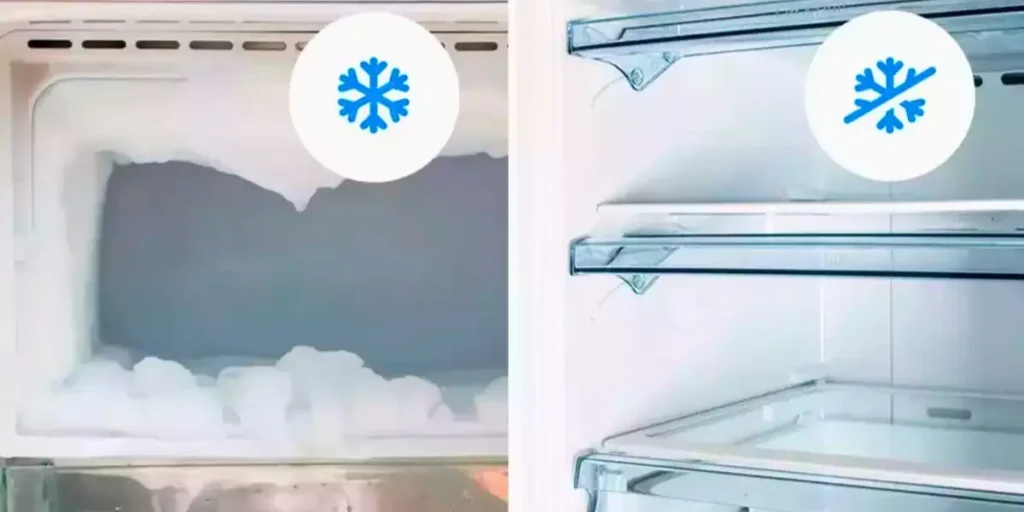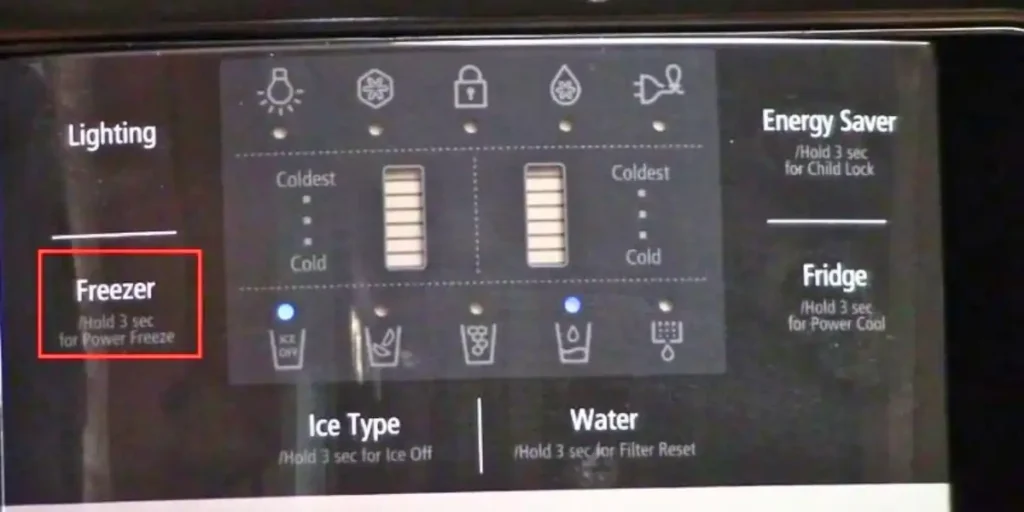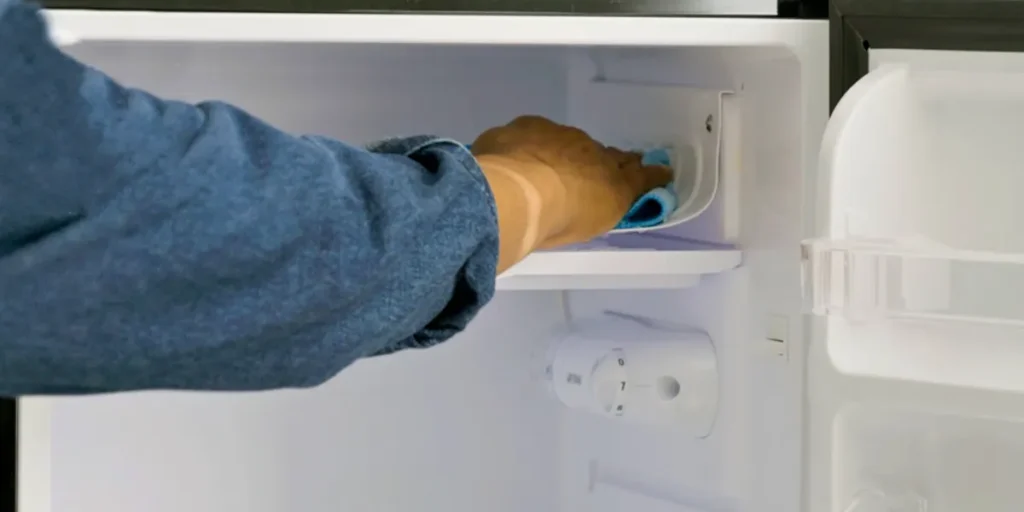Defrosting your refrigerator is a crucial task for maintaining its efficiency and longevity.
This guide will walk you through the process of putting your refrigerator in defrost mode.
We’ll cover everything from understanding your refrigerator type to safety precautions, and cleaning necessities.
Whether you have a frost-free or manual defrost refrigerator, these steps will ensure a safe and effective defrosting process.
Let’s dive into the details!

Why Defrosting is Important for Your Refrigerator
Defrosting helps your refrigerator run more efficiently by improving air circulation.
It can also prevent damage to the refrigerator’s components.
Here are more reasons:
Efficiency
Over time, frost accumulates on the evaporator coils of your refrigerator.
By defrosting, you’re ensuring your refrigerator doesn’t have to work as hard to keep your food cold, thus improving its efficiency.
Longevity
Regular defrosting can help prolong the life of your refrigerator. Frost build-up can put extra strain on the refrigerator’s components, potentially leading to premature wear and tear or even system failure.
Food Quality
Frost build-up can lead to temperature fluctuations that may affect the quality and taste of your food.
Regular defrosting helps maintain a consistent temperature, keeping your food fresher for longer.
Space
Frost takes up space that could be used for storing food.
By regularly defrosting your refrigerator, you maximize its storage capacity.
Types of Refrigerators and Their Defrost Methods

Manual Defrost Refrigerators
These are the traditional types of refrigerators that require you to manually defrost them. This involves turning off the refrigerator and allowing the frost to melt over time.
Advantages: They are usually more energy-efficient and operate more quietly than other types. This means they can save you money on your energy bills and won’t disturb your peace at home.
Disadvantages: The need for regular manual defrosting can be inconvenient and time-consuming. You’ll need to remember to do this every few months, and it can take several hours each time.
Auto-Defrost Refrigerators
Also known as ‘cycle defrost,’ these refrigerators automatically defrost themselves at regular intervals without any input from you.
Advantages: They offer convenience as they save you the hassle of manual defrosting. This means you can spend less time on refrigerator maintenance and more time on things you enjoy.
Disadvantages: They tend to use more energy and may cause freezer burn on your food due to fluctuating temperatures. This could lead to higher energy bills and less tasty meals.
Frost-Free Refrigerators
These refrigerators use a heating element to melt frost on the evaporator coils, which then evaporates and exits the refrigerator through a drain.
Advantages: They never require defrosting, saving you time and effort. You won’t have to worry about remembering to defrost or dealing with a messy clean-up afterward.
Disadvantages: They use more energy than other types, which could increase your energy bills. They can also dry out stored food, affecting its taste and texture.
How to Put Different Types of Refrigerators in Defrost Mode

Each type of refrigerator has a different method for defrosting:
Manual Defrost
To manually defrost your refrigerator, you’ll need to turn it off or unplug it. Once it’s off, open the door and leave it open until all the ice has melted.
This process might take a few hours, so be patient. Remember to remove any food items before you start defrosting to prevent them from spoiling.
Auto-Defrost
Auto-defrost refrigerators are designed to defrost themselves every 6-12 hours. This process is automatic and doesn’t require any action from you.
The refrigerator will briefly increase its temperature to melt any frost build-up, and then return to its normal operating temperature.
Frost-Free
Frost-free refrigerators are a step up from auto-defrost models. They use a heating element to melt frost on the evaporator coils, and a fan to circulate the cold air.
This prevents frost from building up in the first place, so you won’t need to defrost these refrigerators at all!
Factors to Consider Before Putting Your Refrigerator in Defrost Mode
Before you start the defrost process, consider these factors:
Type of Refrigerator
Different types of refrigerators require different defrost methods. For instance, a frost-free refrigerator automatically defrosts, while a manual defrost refrigerator requires you to do it yourself.
Make sure you know your refrigerator type before starting the defrosting process.
Food Storage
Before you start defrosting, ensure all food is stored safely. You might need to temporarily move your food to another refrigerator or a cooler with ice packs to keep it fresh during the defrosting process.
Duration and Timing
Defrosting can take several hours, so it’s best to plan ahead. Start the process when you have enough time to monitor it. Overnight might be a good option for many people.
Safety Precautions
Be careful of water from melting ice during the defrost process. It’s a good idea to place towels around the base of the refrigerator to soak up any water that leaks out.
Energy Consumption
Manual defrost refrigerators use less energy than frost-free models. However, if frost builds up too much, it can cause the refrigerator to work harder and use more energy. Regular defrosting can help maintain energy efficiency.
Cleaning Necessities
After defrosting, you may need to clean up water from melted ice. Having cleaning supplies on hand, like towels and a mop, can make this task easier.
Manufacturer Guidelines
Always follow the manufacturer’s instructions for defrosting. These guidelines are designed for your specific model and will provide the safest and most effective defrost method.
Tips for Effective and Safe Defrosting

Here are some tips for effective and safe defrosting:
Plan Ahead
Defrosting isn’t a quick process. It can take several hours, so plan. Make sure you have enough time to complete the process without rushing.
Empty the Freezer
Before you start defrosting, remove all food from the freezer. Store it in a cooler with ice packs to keep it cold while you work.
Turn Off the Freezer
Switch off your freezer at the mains. This will stop the cooling process and allow the ice to melt.
Catch the Drips
Place towels or a shallow tray at the bottom of the freezer to catch any water from the melting ice.
Checking for Ice Build-up
Regularly check for ice build-up in your refrigerator.
Keeping Food Fresh During Defrost
Store food in a cooler with ice packs during the defrosting process.
Monitoring Temperature
Use a thermometer to ensure your refrigerator is at the correct temperature after defrosting.
Efficient Cleaning Post-Defrost
Clean up any water from melted ice after defrosting.
Use a Scraper
If the ice doesn’t melt quickly, you can use a plastic scraper to help remove it. But be careful not to damage the inside of the freezer.
Clean Up
Once all the ice has melted clean the inside of your freezer with a solution of warm water and baking soda. This will help remove any odors.
Turn It Back On
After cleaning, turn your freezer back on and wait for it to reach its optimal temperature before putting your food back in.
Why Isn’t the Water Dispenser Light Working in Defrost Mode for my LG Fridge?
The defrost mode in your LG fridge may disable the water dispenser light, resulting in the issue of the Water Dispenser Light Not Working. This is likely a design feature, as defrost mode prioritizes the functionality of the cooling system over the light.
What are Some Troubleshooting Tips for a Samsung Refrigerator’s Ice Maker?
If your samsung refrigerator ice maker is giving you trouble, here are a few tips to try. First, ensure the ice maker is turned on and the water supply is connected. Clean the ice maker regularly to prevent clogs. If the ice cubes are small, adjust the waterline. Lastly, reset the ice maker by pressing and holding the reset button for a few seconds. Remember these samsung refrigerator ice maker tips for seamless ice production.
FAQs
How often should I put my refrigerator in defrost mode?
Manual-defrost refrigerators should be defrosted every six months or when frost is more than half an inch thick.
Is defrosting well for my refrigerator?
Yes, it helps your refrigerator run more efficiently and can prevent damage.
What are the signs that my refrigerator needs to defrost?
If you see frost build-up or the refrigerator isn’t cooling properly, it may need to be defrosted.
Can I speed up the defrost process?
Yes, but it’s best to let it happen naturally to prevent damage to the fridge.
Does defrosting save energy?
Yes, a frost-free refrigerator uses less energy.
Conclusion
Tackling defrost mode is a breeze once you get the hang of it! Locate your fridge’s control panel, switch to defrost, and you’re on your way to maintaining an efficient, frost-free appliance.
Remember to empty the freezer first and prepare for some meltwater. Keep your food safe and your fridge humming!
